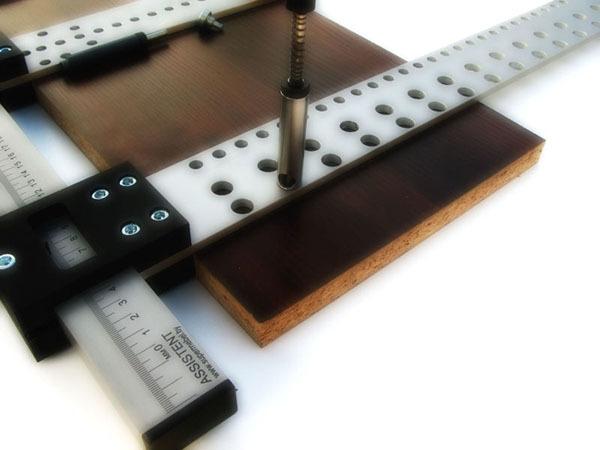Content
-
1 Hinge height
- 1.1 Linkage mechanisms
- 1.2 Preliminary activities
- 1.3 Required tools and fasteners
-
2 Rear wall designs
- 2.1 Construction first
- 2.2 Second design
- 3 Learn more about installing top kitchen cabinets
- 4 Conclusion
Typically, the installation of kitchen furniture starts with the installation of the upper components. The height of the upper kitchen cabinets should be certain, not at random, because they are located at eye level, so the error in the calculations will eventually be noticeable.

Hanging cabinet - not only the aesthetic side of the issue depends on the correct hinge
In addition, hanging cabinets are often used for storing any heavy items. Therefore, not only the aesthetics of perception of the kitchen as a whole, but also the reliability and practicality of the entire structure depends on the correct hinge.
Hinge height
The mounting height of the upper cabinets is determined by:
- the immediate height of these pieces of furniture themselves;
- or the growth parameters of the owners of the kitchen.
Know! In modern life, it is considered to be the normal height of the hinge - 50-60 cm above the level of the countertop.
This allows you to comfortably use electrical appliances placed on the work surface:
- Food processors;
- toasters;
- kettles, etc.
The minimum height of the cabinet hinge (according to GOST) is 45 cm above the table top level (see also article Height of wall cabinets in the kitchen - how to choose the right one). In the event that there is a tall pencil case in the headset, or if hanging pedestals need to be placed above the refrigerator, everything will be determined according to the height of these elements.

Optimal distance from the worktop (work surface) to the lower edge of the cabinets and the hood
Linkage mechanisms
Using modern fittings, you can:
- greatly facilitate the work associated with the installation of kitchen cabinets;
- correct subtle marking errors;
- significantly improve the reliability of the structure as a whole.
In order to fix the upper cabinets, the mechanism is mainly used - "mounting rail (strip) - hinge".
The hinge is attached with a hook to the side inner wall of the furniture so that this hook protrudes somewhat from the rear wall of the furniture. On the wall where the cabinet will be hung, a mounting rail is fixed on which the hook of the hinge is attached. It's easy to do it yourself.
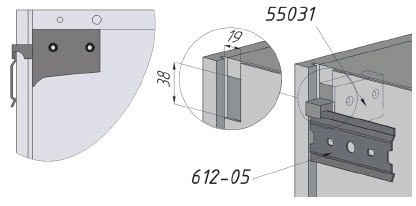
Hanging upper pieces of furniture on a mounting strip using hooks
Preliminary activities
- First of all, the walls should be as vertical and even as possible. For corner kitchens - the mating corners should be clearly at an angle of 90 degrees.
- All electrical work must be completed, sockets for the kitchen hood installed, and also laid terminals for connecting upper lighting fixtures located on the visor or roof of the kitchen headset.
- Above and below wall cabinets for the kitchen must be painted or wallpapered. After all, after hitching, it is quite problematic to do this.
Required tools and fasteners

The drill for the drill will need to be selected in accordance with your walls
You will need the following tools to hang the kitchen cabinets:
- for a load-bearing wall that does not lend itself well to the drilling process - a drill, preferably with a perforator;
- roulette;
- screwdriver (or screwdriver);
- the level is long;
- clamps;
- a hammer;
- wrench (in case an anchor will be used to secure the mounting rail).

Canopies can be selected not only by color, but also by quality - the price will vary slightly
Before starting work, you will need to take care of the following fasteners:
- screws required for fixing cabinets to hinges; they are usually included. Quite often, manufacturers use press hinges - they do not require separate fasteners, because they are installed directly at the factory;
- other screws - with dowels for fixing the hinged rail to the wall (you should use the fasteners required specifically for your type of walls);
- intersectional ties, which are used to connect furniture sections together.

Types of fasteners with and without dowels
Rear wall designs
Construction first
- Hardboard is nailed to the back wall of the cabinet with nails.
- When hanging with the help of a "mounting rail - hinge", the upper pedestal will rest on the top loosely, therefore, in order for it to hang evenly, you need to also achieve the same indentation from walls.
- The bottom of the cabinet (at least 1 - 1.5 cm or more) should be over the apron. Thus, the installation of hanging pedestals should be carried out with a kitchen apron prepared in advance.

The height of the upper kitchen cabinets has been adjusted. Attaching and installing the mounting rail
Second design
- We insert the hardboard into the grooves of the walls of the cabinet, thus going a little deep inside the furniture. This design allows you to press the furniture much more tightly against the wall, so the cabinet can be hung with an overlap on the apron, or it can be placed close to the top above it.
- If the installation of the kitchen apron has already been carried out, then using a level you should check whether it was exactly made in a horizontal position. If there are deviations from the horizon, then the aligned cabinets (by level) in one place will fit tightly to the apron, in the other, the gap between them and the apron will be noticeable.
- Then the lockers should be hung with an overlap on the apron - this will partially hide such shortcomings.
- If the apron has not been installed, it is recommended in this case to first hang the cabinets, aligning them along a horizontal line, and only then install the apron itself.
- It is this sequence that will lead to the most tight fit of the kitchen backsplash and wall cabinets.
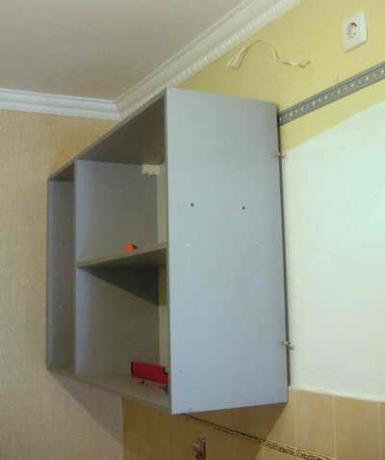
Top cabinet mounted on a mounting rail, level
Learn more about installing top kitchen cabinets
Instructions:
- Set the hook to the middle position with the adjusting screws.
- Install the hinges on the side inner walls in such a way that the hook extends a few millimeters beyond the rear wall and is able to catch on the mounting rail.
- On the wall, make a marking for drilling the necessary holes to secure the hanging rail. The following rules should be followed:
- If the height of the hanging cabinets in the kitchen is determined by the dimensions of the refrigerator or kitchen cabinets, you must first install these particular items;
- Using the "mounting rail - hinge" mechanism, you need to determine how the cabinets will be installed: end-to-end with a kitchen apron or overlapping;
- The hinged rail should be located slightly below the top line of the hinged pedestals. This distance should be measured by attaching the rail to the back wall of the cabinet in such a way that it is already hung on the rail;
- Starting with a corner cabinet and using a level, draw lines on the wall that represent the top of the headset, as well as the top edge of the hanging rail.

Hitch with hook attached to the side wall
Important! When determining the horizontal position of the upper cabinets, it is best to use a level, but do not measure the distance from the ceiling to the floor - an error may occur due to curvature. But if you are sure of the evenness of the ceilings and floors, you can simply check the resulting markings with a level.
- We apply the hinged rail with the upper edge to the required drawn line, make markings for the drilling holes;
- If the walls are load-bearing, you can save on breaking the rail into 10 cm pieces, fixing them directly at the locations of the hinges. But this will not work if you doubt at least a little about the reliability of the walls - then it is better not to break, but to fix the entire rail with as many fasteners as possible (see also article Fixing kitchen cabinets to the wall is easy).
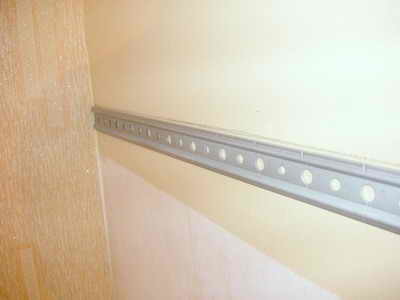
Determination of the height of wall cabinets and mounting rail
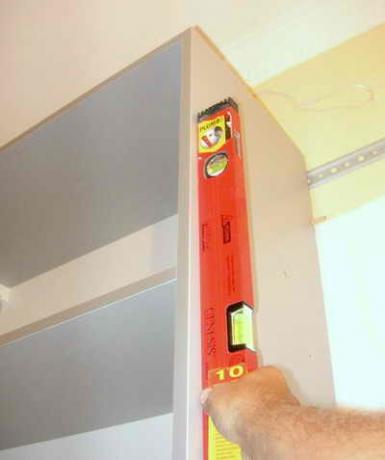
Before using the intersection screeds, it is necessary to level the sections and fasten them
Conclusion
Guided by this article, you can independently carry out a hinge of kitchen cabinets - there is nothing complicated here. However, if you did not find sufficient information for yourself, on our portal there are more detailed photo materials and video lessons from specialists.

